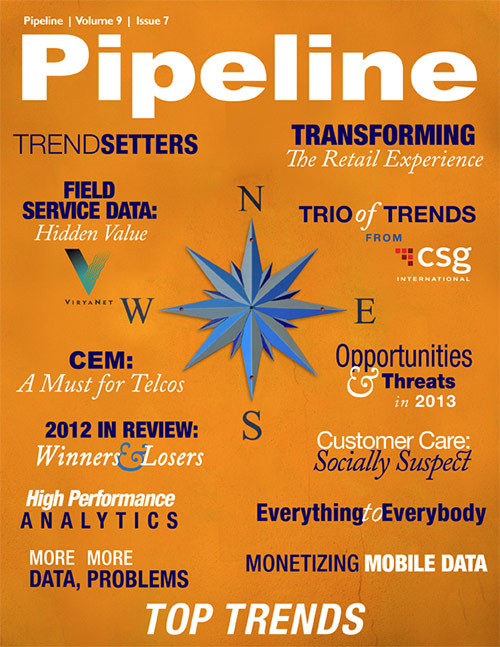The Top Trendsetters of 2012
By: Tim McElligott

We pay a great deal of attention to trends in this industry. We follow consumer adoption trends. We track trends in utilization. We even glance at what’s trending on Twitter. Mostly we try to get in front of trends and gain a first-mover advantage. They’ve come in waves: the great digital transformation, broadband, equal access, VoIP, the IP Multimedia Subsystem, and convergence, and now the cloud, social media, big data, personalization, the Cambrian-like application explosion, and machine-to-machine (M2M) communication.
However, every trend requires a trendsetter. Where would the resurgent fedora be without Justin Timberlake? And who in America would be eating Greek yogurt without Yiayia, the angry grandmother from Athenos?
The telecom industry’s trendsetters are more subtle, their influence more like a persistent wind at one’s back than an ultimately fickle fashion choice. The contributions of telecom trendsetters also tend to be more permanent. Sure, they’re eventually eclipsed by new technologies, but more often than not, like science itself, they grow incrementally over time, their work leveraged and resting upon the shoulders of giants in order to see a better way forward, not just a different way.
About ConceptWave
ConceptWave is a leading provider of customer, product, and order lifecycle management solutions that enable communications service providers to rapidly introduce new market offers and to empower superior customer experience. ConceptWave's unique offer is to provide an end-to-end catalog-driven suite of order fulfillment automation software with ConceptWave Order Care and Rapid CRM. ConceptWave products and solutions enable service providers to address competitive requirements and simplify the management of customers, products, and orders, for any product, on any network, in any market, using any channel. ConceptWave is headquartered in Toronto with presence in Americas, Europe and Asia.
The following leaders in telecom were trendsetters in 2012, and their contributions will be felt in 2013 and beyond. When the trends they created are eventually eclipsed by something new, they will remain part of the fabric that supports the most advanced and creative communications network in the universe.
APPLICATION DEVELOPMENT
Peter Hill
Vice president of ecosystem and innovation
AT&T Foundry
Application development may give communications service providers the single greatest competitive edge they can muster in the coming years, aside from the quality of their networks. And when
it comes to app development, the AT&T Developer Program has ranked among the best for the last six years.
A survey by Evans Data Corporation ranked AT&T the highest among U.S. wireless operators in all categories: mobile application distribution, best tool offerings, supported technologies, and market potential. Thousands of developers attend its summits.
AT&T and its technology partners have invested approximately $70 million to create the three innovation and development centers that now comprise the AT&T Foundry. Peter Hill has primary responsibility for the centers, and said they would not be developing simple iPhone apps. Instead, they would develop platforms, back-office applications and enterprise software. He anticipated reviewing 400 applications per year and participating in the development of six to eight promising ideas annually. In 2011 his group reviewed 500 applications, deployed 10 and had more than 100 active projects by year’s end. It also conducted 56 developer events.
One successful project has been AT&T Toggle, which gives mobile professionals the option to use their smartphones and tablets for both business and personal use. Another, SimpleView, provides automated video billing for AT&T U-verse subscribers. Hill said AT&T’s collaboration with SundaySky through the AT&T Foundry demonstrates how quickly a great technology can be fast-tracked “to deliver a valuable service for AT&T customers.”




















